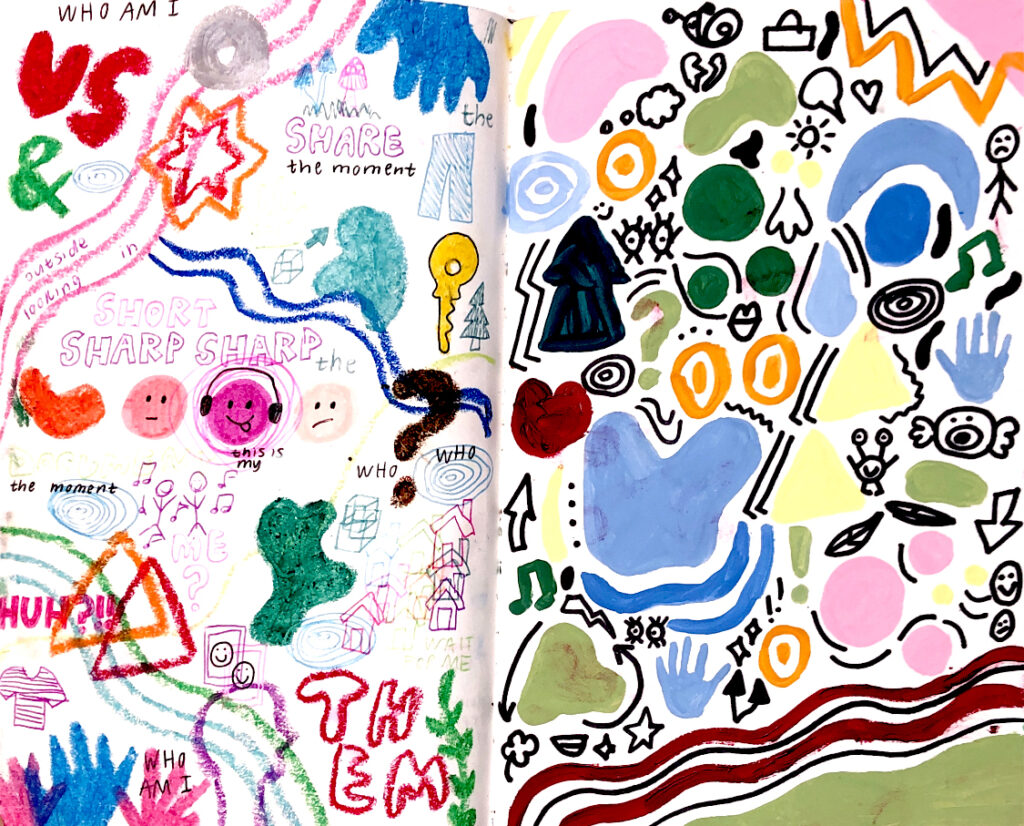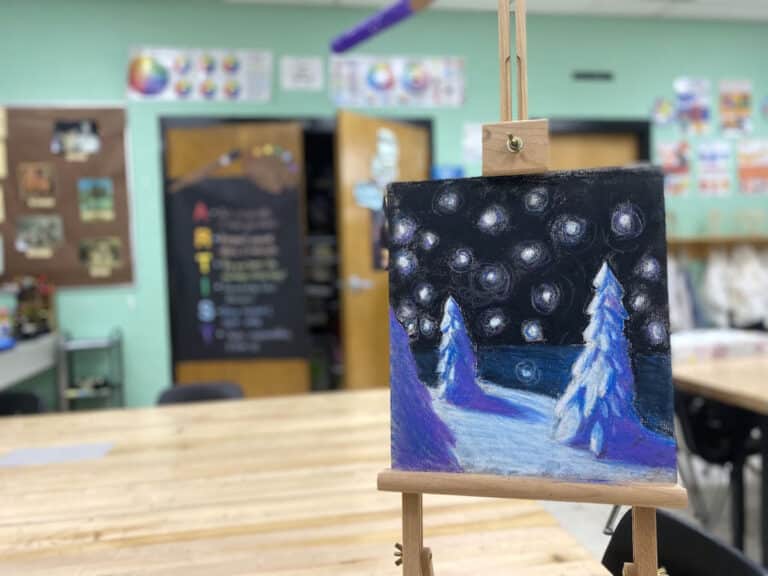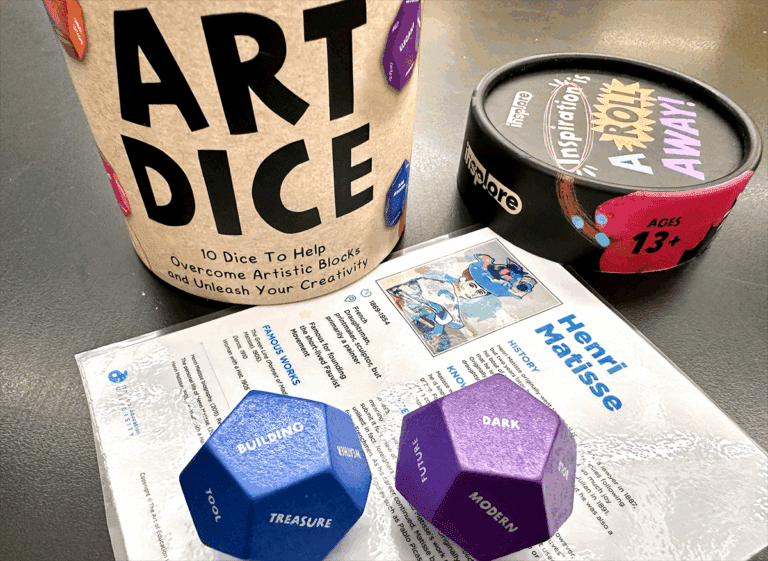Visual Journaling is a great way to support our students’ social-emotional needs while connecting with our curriculum. Students can safely practice and explore both media and ideas in their sketchbooks and decompress from the day. When it comes to our advanced artists, visual journaling helps students whether they are just starting an artwork, stuck in the middle, or struggling to finish. Make time in your routine and space in their journals for this creative thinking routine.

What is visual journaling?
Visual journaling is like keeping an artistic diary. Whether you call it a visual journal or a sketchbook, this is a space to create, explore, meditate, and practice. It is a space where no one without judgment where nothing needs to be complete. Your visual journal is just for you—some artists journal every morning to start their day, while others journal when they feel the need.
The 10 Best Supplies for Visual Journaling
Unlike a sketchbook where you teach students to plan out their artwork, a visual journal is more organic. It could absolutely contain sketches for artwork, but it also could not. When using a visual journal with advanced students, it’s important to explain the purpose and differences. By making this sketchbook intimately theirs, students will take ownership of their work and their journaling habits.
However, one thing to be mindful of is the content that a student creates in a sketchbook is still under your supervision. As a mandatory reporter, students need to know that any concerning content in the book will be discussed with parents and school team members. Remind students you are there to support them and will notify appropriate resources when needed.

How often should you use a visual journal?
Visual journaling takes practice and routine. If you only ask students to do this once a month, they won’t get into good habits. Build time into your lessons to teach visual journaling. Then, make sure to set a routine for students to practice their art exploration. Whether you take ten minutes a day or designate a specific day of the week, students look forward to their journaling time.
Visual journaling can be extra helpful during long stretches of studio time. Students who struggle with surface-level ideas or muddy concepts benefit from practicing in a safe place, away from their high-risk artwork. Sometimes we need a break in the middle to step away from our work. Journaling can also help us with revision when we’re unsure of what our nearly completed artwork is missing. When in doubt, students can always pull out their sketchbooks and journal to support their creative process.
How can you use visual journaling?
Safe Space
Students can use this safe space to jot down ideas, ruminate, and explore concepts. They can let loose and explore media without fear. Provide a prompt for students to consider or leave it up to them. Students can make their own journals from scratch, they can purchase on their own, or you can provide a journal for them.
Exploring Visual Journals at the Secondary Level PRO Learning Pack
Not all students love to draw or feel confident in their drawing skills. Support students with a range of media to explore. When students start their visual journal, remind them that this is an open world of possibilities; nothing is a failure, and everything is simply an exercise or exploration.

Collect and Organize
Another way to use visual journaling for ideation is to create an inspiration board. An inspiration board is a collection of materials, ideas, and research to help you find your interests. Students research artists they are drawn to, find color palette swatches from the hardware store, clip examples of media techniques, practice some hatching. Whatever they are interested in exploring, the inspiration board helps students define their interests and find common threads.

Visual journaling to create an inspiration board is about collecting and arranging materials to tell a story. It’s through the time spent organizing and creating that students get into their creative flow.
Brain Dump
Dumping ideas and thoughts down in writing or visually can help students sift through their daily stressors and relax. Start with a stream of consciousness writing exercise or simply have students write down their to-do list. The idea behind a brain dump is to get rid of all those nagging thoughts that interfere when we’re trying to focus on our specific artistic goal. Sometimes those thoughts can be used to fuel your creative thinking, but mostly you just need to clear the weeds from the path. Taking time to do a brain dump also helps our nervous system stay grounded and present in the moment.

Focus and Direction
After working on artwork for a month or longer, we often lose our vision and purpose. Our original ideas become muddled, and we aren’t exactly sure where we are going. This especially happens in advanced classes when students work on multiple artworks over a much longer length of time.
6 Easy Ways to Incorporate Text in Your Visual Journal
When students seem stuck or veering on the wrong path, take a day to refocus through visual journaling. Turn out the lights and guide students with targeted questions. To start, students write down their concept, theme, or idea in a “cool font.” As they draw this out, talk to your students about the benefits of visual journaling. When we take our time to write something out, re-write, or design words, we are practicing mindfulness and focusing our thoughts. Encourage students to doodle, draw, or jot down thoughts as they are highly focused on their idea or theme.
While visual journaling supports artists at any level, advanced students benefit from consistent practice as they build their artistic habits. Whether students are in the planning or completing phases of their process, visual journaling is an easy way to encourage exploration and provide a safe place for practice.
How do you use visual journaling in your advanced classes?
How can you support consistent visual journaling habits at any level?
Magazine articles and podcasts are opinions of professional education contributors and do not necessarily represent the position of the Art of Education University (AOEU) or its academic offerings. Contributors use terms in the way they are most often talked about in the scope of their educational experiences.






